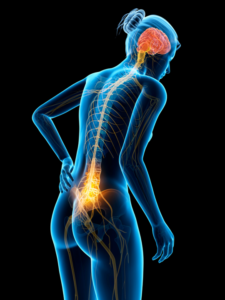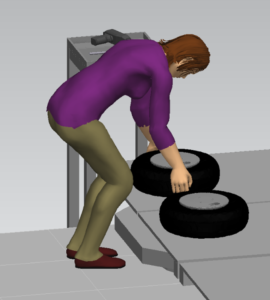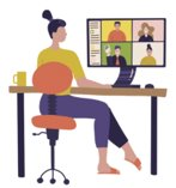Getting back to school means getting back to the books, and that means back packs. To ensure the school year is a safe and healthy one, make sure your back pack does double duty supporting both your books and your back!
Here’s how!
The perfect back pack:
- is light weight,
- has two wide padded shoulder straps,
- has a waist strap,
- has a padded back, and
- has multiple compartments to help distribute the load.
How to load a back pack
- A child should carry no more than 10% of their body weight
- Heavier items go closest to the back
- Make sure items are snug so there is no shifting
- Only carry items needed for that day, saving unnecessary weight
How to carry a back pack
- Always carry a backpack on both shoulders
- The shoulder straps should be well-padded for comfort
- Emphasize using the waist strap. Waist straps, in combination with shoulder straps, help to distribute the weight more evenly. The bottom of the backpack should rest on the lower back where the spine is curved. This location is approximately four inches below the child’s waistline.
- The shoulder straps should be adjusted so that the backpack is tight to the back and not hanging loosely.
- Kids grow, so should their school back. Make sure to update based on needs and body size.
For more tips and to see references, check out the full article below.
—
In the United States more than 40 million grade-school and college students carry a backpack to and from school each day. According to the American Occupational Therapy Associations more than half of these students may be carrying too much in their backpack, as well many of them may not be wearing their backpacks properly.
In 2001, 7000 emergency room visits were backpack and book bag related. Half of these visits occurred in children 5 to 14 years of age. This hazard is often overlooked by parents, teachers, and students. Previous studies have recommended a backpack weight to be less than15% of the users body weight, however decreasing the recommended weight to 10% can decrease the use of medical services or interferences associated with school activities and attendance (Moore et al., 2007).
Common symptoms associated with carrying a heavy backpack include aching back and shoulders, tingling arms, weakened muscles, and stooped posture. If the backpack is carried on one shoulder only, the child may bend over sideways to compensate for the weight.
Parents should also consider how the child will be using the backpack. For example, if the school has numerous stairs, a backpack would be preferred as a wheeled bag could be considered a safety hazard if pulled up and/or down the stairs. Walking distance should be taken into consideration when purchasing and packing your child’s backpack. Teachers should also make an effort to reduce the amount of supplies/books that they require their students to carry in their backpack.
When loading your child’s backpack, keep these tips in mind:
- Never load the backpack to more than 10% of the child’s body weight. For example, if your child weighs 100 pounds, the backpack should have a maximum weight of 10 pounds.
- Items that are the heaviest should be located closest to the child’s back.
- Items should be arranged in a tight manner so that they do not shift around when walking.
- Make sure the child is not carrying additional items that are not needed for the day. The only items in the backpack should be those that are necessary for the current day.
- If the backpack is more than 15% of the child’s body weight, consider using a book bag on wheels, if appropriate.
When carrying the backpack, keep these tips in mind:
- The backpack should always be carried on both shoulders. Wearing a backpack on only one shoulder can cause curvature of the spine, uneven posture, pain and discomfort.
- The shoulder straps should be well-padded for comfort. If too much pressure is applied on the shoulders and back, the blood vessels located around the area can become compressed and may cause pain and tingling in the shoulders and neck, as well as the arms and hands.
- Emphasize using the waist strap. Waist straps, in combination with shoulder straps, help to distribute the weight more evenly. The bottom of the backpack should rest on the lower back where the spine is curved. This location is approximately four inches below the child’s waistline.
- The shoulder straps should be adjusted so that the backpack is tight to the back and not hanging loosely. A loose backpack has more room to swing freely; therefore the load can pull the child from side to side with each step and strain their muscles.
- More importantly, update your child’s backpack over the years. School backpacks come in various sizes for a range of different age groups. Therefore, select the proper backpack for the child and make sure there is enough room for all the necessary school items.
References:
American Occupational Therapy Associations, Inc. (2004-2008),
https://www.promoteot.org/AI_BackpackStrategies.html
Kids Health for Parents (2007),
https://kidshealth.org/parent/positive/learning/backpack.html
Moore MJ, White GL, Moore DL. (2007) Backpack Weight: How heavy is safe? Grant AAP Grand Rounds. 18: 10-11








 Why Sandalwood?
Why Sandalwood?


 We are a one-stop-shop for launching job rotation for any employer from conception to implementation. Our experts tailor our services to meet the needs of our customers by collaborating with them throughout the entire process. We do not offer cookie cutter solutions for job rotation because the needs of employers vary significantly.
We are a one-stop-shop for launching job rotation for any employer from conception to implementation. Our experts tailor our services to meet the needs of our customers by collaborating with them throughout the entire process. We do not offer cookie cutter solutions for job rotation because the needs of employers vary significantly. Why Sandalwood?
Why Sandalwood?



 Sandalwood is pleased to offer solutions above and beyond the traditional ergonomic assessments. With an in-depth knowledge of various digital human modelling software suites, integration and adoption to your health and safety programs has never been easier. Sandalwood is experienced in ergonomic program design as well as industry leaders in digital human modelling services. We have a diverse team that is able the leverage the results from the digital human model to provide in depth risk assessments of future designs and current state. Sandalwood is also able to pair these assessments with expertise and provide guidance on the best solution for you. Sandalwood is also on the forefront of emerging technologies and able to integrate Motion capture, Wearables, and extended or virtual reality into your ergonomic program.
Sandalwood is pleased to offer solutions above and beyond the traditional ergonomic assessments. With an in-depth knowledge of various digital human modelling software suites, integration and adoption to your health and safety programs has never been easier. Sandalwood is experienced in ergonomic program design as well as industry leaders in digital human modelling services. We have a diverse team that is able the leverage the results from the digital human model to provide in depth risk assessments of future designs and current state. Sandalwood is also able to pair these assessments with expertise and provide guidance on the best solution for you. Sandalwood is also on the forefront of emerging technologies and able to integrate Motion capture, Wearables, and extended or virtual reality into your ergonomic program.



